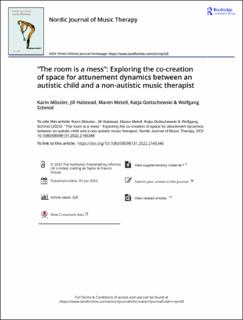| dc.contributor.author | Mössler, Karin | |
| dc.contributor.author | Halstead, Jill | |
| dc.contributor.author | Metell, Maren | |
| dc.contributor.author | Gottschewski, Katja | |
| dc.contributor.author | Schmid, Wolfgang | |
| dc.date.accessioned | 2023-01-17T08:39:25Z | |
| dc.date.available | 2023-01-17T08:39:25Z | |
| dc.date.created | 2023-01-13T14:22:19Z | |
| dc.date.issued | 2022 | |
| dc.identifier.citation | Nordic journal of music therapy. 2022, . | en_US |
| dc.identifier.issn | 0809-8131 | |
| dc.identifier.uri | https://hdl.handle.net/11250/3043862 | |
| dc.description.abstract | Introduction Music therapy practice and research in the field of autism has often followed medical narratives that reinforce neurotypical normalcy by locating the difficulties of social interaction in the autistic person. By exploring the relational phenomenon of attunement, this paper focuses on the social and material ecology of interactions. The authors try to unpack circumstances that can support or hinder attunement dynamics between autistic and non-autistic people. Method A video-vignette from music therapy with an autistic boy, who explores the sound of building blocks formed the point of departure for this research. The vignette was self-identified by the music therapist as an apparently failed attunement experience. Based on this vignette, we conducted an interview with the therapist and focus groups with parents of autistic children and colleagues from different professions, one of whom is autistic. We used an interpretative hermeneutical methodology for crystallisation of perspectives. Results We uncovered four spaces that impacted on the mutuality and co-creation of attunement dynamics. The room (physical space), the school context (professional space), and the material (sensory space) afford the interaction (relational space) between the child and the therapist in enabling and disabling ways. Listening to the child's sound making with the building blocks was identified as the autistic child’s way of knowing and sounding that needs to be listened to carefully, rather than being questioned or disregarded. Discussion Findings of this research might encourage therapists to foster an understanding of social interaction that is mutually co-constituted and enactive, and that contradicts the mainstream pathologisation of autism. | en_US |
| dc.language.iso | eng | en_US |
| dc.rights | Navngivelse 4.0 Internasjonal | * |
| dc.rights.uri | http://creativecommons.org/licenses/by/4.0/deed.no | * |
| dc.title | The room is a mess: Exploring the co-creation of space for attunement dynamics between an autistic child and a non-autistic music therapist | en_US |
| dc.title.alternative | The room is a mess: Exploring the co-creation of space for attunement dynamics between an autistic child and a non-autistic music therapist | en_US |
| dc.type | Peer reviewed | en_US |
| dc.type | Journal article | en_US |
| dc.rights.holder | © 2022, The Authors | en_US |
| dc.description.version | publishedVersion | en_US |
| cristin.ispublished | true | |
| cristin.fulltext | original | |
| cristin.qualitycode | 2 | |
| dc.identifier.doi | 10.1080/08098131.2022.2145346 | |
| dc.identifier.cristin | 2106673 | |
| dc.source.journal | Nordic journal of music therapy | en_US |
| dc.source.pagenumber | 21 | en_US |

